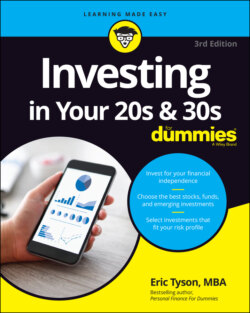Читать книгу Investing in Your 20s & 30s For Dummies - Eric Tyson - Страница 21
Managing risks
ОглавлениеThroughout this book as I discuss various investments, I explain how to get the most out of each one. Because I’ve introduced the important issue of risk in this chapter, I would be remiss if I also didn’t give you some early ideas about how to minimize those risks. Here are some simple steps you can take to lower the risk of investments that can upset the achievement of your goals:
Do your homework. When you purchase real estate, various inspections, for example, can save you from buying a money pit. With stocks, you can examine some measures of value and the company’s financial condition and business strategy to reduce your chances of buying into an overpriced company or one on the verge of major problems.
Diversify. Placing significant amounts of your capital in one or a handful of securities is risky, particularly if the stocks are in the same industry or closely related industries. To reduce this risk, purchase stocks in a variety of industries and companies within each industry. Even better is buying diversified mutual funds and exchange-traded funds. Diversifying your investments can involve more than just your stock portfolio. You can also hold some real estate investments to diversify your investment portfolio. If you worry about the health of the U.S. economy, the government, and the dollar, you can reduce your overall investment risk by also investing overseas so that you have a globally diversified portfolio of stocks. Most large U.S. companies do business overseas, so when you invest in larger U.S. company stocks, you get some international investment exposure. You can also invest in international company stocks, ideally through funds.
Minimize holdings in costly markets. Although I don’t believe that most investors can time the markets — buy low, sell high — spotting a greatly overpriced market isn’t too difficult. You should avoid overpriced investments because when they fall, they usually fall farther and faster than more fairly priced investments. Also, you should be able to find other investments that offer higher potential returns. Throughout this book, I explain some simple yet powerful methods you can use to measure whether a particular investment market is of fair value, of good value, or overpriced.
View market declines in a different light. Instead of seeing declines and market corrections as horrible things, view them as potential opportunities or “sales.” If you pass up the stock and real estate markets simply because of the potential market-value risk, you miss out on a historic, time-tested method of building substantial wealth. Try not to give in to the human emotions that often scare people away from buying something that others seem to be shunning.
